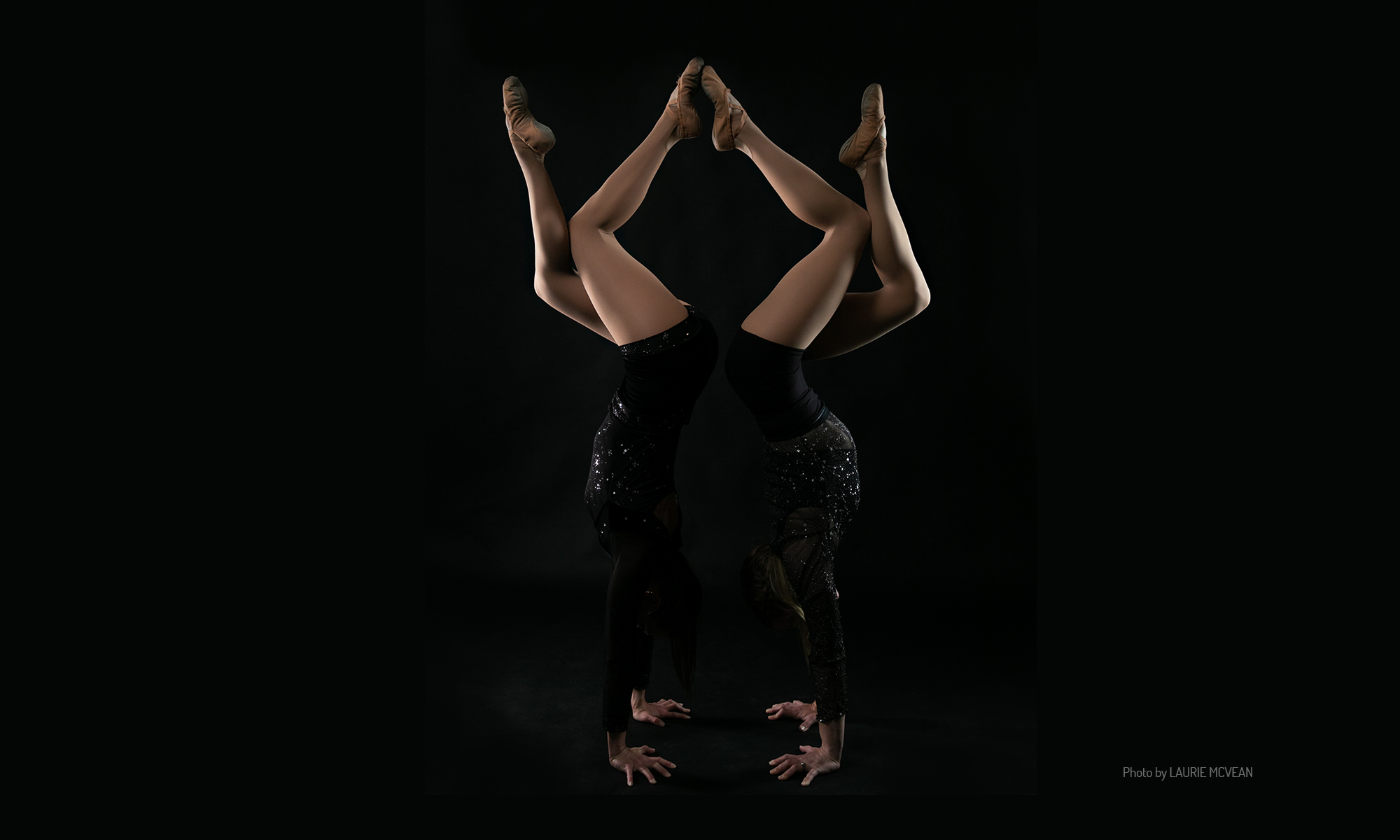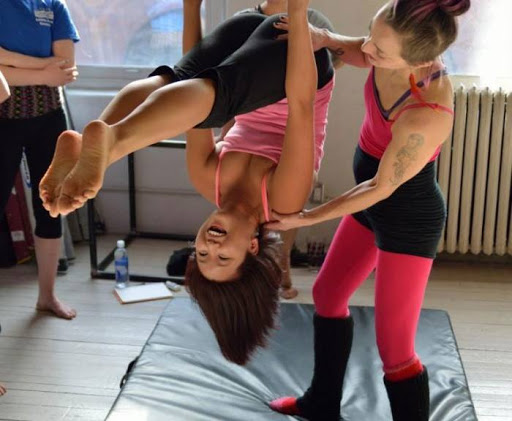As aerial coaches, after people learn what we do, we often hear them say… “I wish I could do that.”
Our response… “What’s stopping you?”
Maybe you’ve seen clips of acrobats from Cirque du Soleil, or have a friend who’s dabbled in aerial arts. Maybe you’ve considered trying it out yourself. But maybe an aversion to risk – or a fear of the unknown – has held you back.
Trying anything new can be daunting, let alone an acrobatic art form that takes place in the air surrounded by a group of people. With your feet on the ground and your upper body strength more aspirational than actual, it can be difficult to even know where to get started.
The very first step to getting started in aerial arts is simple, but requires a little research.
Your first step is to find a studio.
(Told you it was simple.)
The next step: figuring out which one to try!
We know that as exciting as it is to do something new, you may have plenty of questions.
How do you know what to look for when you don’t even know what you’ll be doing?
What should you look for in a studio?
Which class should you take?
What questions should you ask?
Below, we’ve collected our best tips for finding an aerial studio that’s a good fit for you so you can finally get to class and get airborne.
Aerial arts – NOT aerial yoga
Aerial yoga has grown in popularity over the years. It’s offered at yoga studios, aerial studios, community centers, and at wellness retreats around the world.
But let’s get one thing clear…
Aerial yoga is not an aerial art.
Confusing aerial arts for aerial yoga is a common mistake, one that students will sometimes make even after their first class.
While aerial yoga tends to involve flowing movements and meditation that builds a strong mind-body connection, aerial arts classes operate more like athletic training, with warm ups, conditioning, and repetition of specific drills and skills.
Aerial yoga is performed on a hammock apparatus – a loop of aerial fabric – while aerial arts may be performed on hammocks, split-panel fabrics, aerial rope, trapeze, lyra (aerial hoop), and more.
Furthermore, in a yoga class, you’ll usually be given cues to follow throughout the whole class, linking each movement with your breath, while in aerial arts you’ll be taught a series of moves which you will then practice repeatedly over the course of class.
Both classes can be fun and offer a connection to your body and an opportunity to build strength and flexibility – but they are distinctly different. Make sure you know which form of aerial movement a studio offers.
Stomping Ground Studio does not teach aerial yoga, though some of our coaches are certified (land) yoga instructors.
Drop-ins or sessions?
One big variation between studios is whether they offer classes on a drop-in or session basis.
Drop-ins mean that you are only committing to a single class. The students in attendance may vary from week to week, as will the skills and techniques you focus on. Drop-ins are popular because they only require payment for one class at a time, and can fit a busy student’s schedule.
In a session format, you will commit to classes on the same day, at the same time, for a given length of time (often 4-10 weeks). This format can be beneficial for beginners because you will build skills in a linear progression.
Be sure to read studio policies and schedules carefully so you understand which class model is followed.
Stomping Ground currently offers classes only on a drop-in basis, meaning you can create your own training schedule and come to classes when it’s most convenient for you.
Find the right class
Not all aerial studios operate the same way. Most will offer an array of classes that depend on their training focus or facility logistics.
A studio may be a circus studio that offers juggling, tumbling, or acrobatics in addition to aerial arts. If it’s primarily a performance studio that also offers classes, there may be a focus on quality of movement or choreography. Some studios offer only pole, lyra, or trapeze, and not vertical apparatuses like fabric or rope – particularly if their ceiling height is lower than 10 feet.
Before you commit to a class, be sure to look through class descriptions on a studio’s website to see what you’re in for. A solid class description should give you an idea of the apparatus used, as well as the primary focus of instruction and any necessary prerequisites.
Don’t see the information you need? Reach out to the studio directly to tell them you’re new to aerial and want to be sure to register for the right class.
Some studios will even offer an introductory class or workshop so you can get a feel for what to expect.
At Stomping Ground, all beginning aerial students should register for a Level 1 or mixed-level class. We offer Tissu 1, Lyra 1, or a chance to explore both these apparatuses with Aerial 1 – Mixed Apparatus. Handstand and Flexibility classes are open to students of all experience levels.
Take a look at your instructor(s)
Not only will doing a little research on your instructor before class make you familiar with their face – it will help you understand their strengths and style as a teacher.
If a studio you’re interested in has multiple instructors, take some time to learn about them and see which one might be the best fit. You can often find instructor bios on a studio’s website, or see pictures or videos of them in action on social media.
If you have a strong athletic background and like to be pushed physically, a teacher who was a former athlete or a personal trainer might meet your needs well. On the other hand, perhaps you’re interested in performing, and want to find a teacher with a background in dance, theatre, or clown.
You can find the bios of Stomping Ground Studio’s coaches right here.
Perform a casual safety check
You certainly don’t need to be a professional rigger to be able to take an aerial class – but knowing a few safety essentials will help you feel confident that you’re in good hands at your chosen studio.
Here are a few things to look out for:
- Good rigging. Again, you don’t need to be an expert! Just take a look up at the rig points (the hardware and fixed mounts from which your apparatus is hung) to see what’s happening up there. Gear should be attached to something solid – like a wood or metal beam – that spans from one point to another. It may also be secured to a sturdy eye-bolt that is driven through a solid material (like cement or metal). Sometimes, a rig will involve a system of ropes and pulleys. All of these would be normal to encounter in an aerial classroom. All rigging should be visible and look relatively neat and tidy – no loose straps or danglies hanging around.
- Thick mats. If you are leaving the ground or going upside down, you should have a good mat underneath you – at least a couple inches thick. If you are working over bare cement floors or using only thin padding (like yoga mats) underneath you, that could be a sign that this studio is not taking your safety seriously. Bring any questions or concerns to a studio owner or administrator. They should be able to clearly address your concerns.
- Sign a waiver. All studios should have an insurance policy in place and should have you sign a waiver with any necessary medical info, including the name of an emergency contact. While serious injuries or lack of consciousness should be very rare, a good studio will be prepared for the worst case scenario!
Aerial arts can be fun, exciting, and a healthy challenge for your body and mind.
We at Stomping Ground Studio want to make sure you walk into classes feeling confident and prepared.
If you have more questions about classes, instructors, or our safety measures, don’t hesitate to reach out and ask!
P.S. – Later this month, we’ll be giving you more information on exactly how to prepare for your first class – from what to eat (or not) to how to dress. Be sure to check back in so we can set you up for success!


